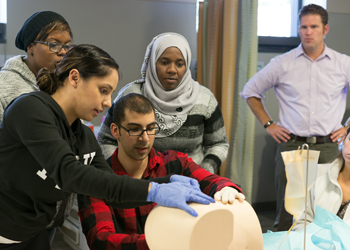As part of its diversity, equity and inclusion strategic plan, the University of Michigan School of Nursing has an ambitious goal.
The unit launched a multifaceted plan to significantly increase the proportion of faculty, staff and students from populations underrepresented in nursing, including men of African-American, Asian, Hispanic and Native American descent.
Traditionally, the profession has been dominated by Caucasian women, says Patricia Coleman-Burns, professor of nursing and co-lead of the unit’s diversity, equity and inclusion implementation team.
Fall 2015 enrollment numbers show that just 61 of the 668 undergraduate nursing students, or 9.1 percent, are men, and only 18, or 2.7 percent are men of color.
The school’s DE&I plan aims to create new networks that would help recruit and retain faculty, staff members and students from educationally and economically disadvantaged districts and from health professional shortage areas. Recruiting first-generation students also is a goal. This would help create a more heterogeneous environment in terms of gender and ethnic makeup of the community.
In order to successfully execute the goals, Coleman-Burns says, the school has to overcome several challenges, including those that exist within its current recruiting habits.
“One consistent challenge will be the competition with other universities and schools of nursing for a relatively small current pool of faculty who are in these groups,” she says.
“We have to reach young people at the middle-school age to guide them through a college-bound curriculum. We will work on developing and nurturing partnerships and trust between U-M’s School of Nursing and communities so that we can be a place of education, work and scholarship these desired groups seek.”
Nursing Dean Patricia Hurn, the other co-implementation lead for the unit, says the school has had some success in the past, but going forward it needs to build on its reputation of producing students from underrepresented populations who go on to become faculty, researchers and health care leaders.
“Students, staff and faculty whose commitment to scholarship and service or clinical practice focused on improving the health outcomes of communities is the biggest benefit to U-M’s School of Nursing,” Hurn says.
She also noted the importance of adding to the diversity of the staff members who don’t directly care for patients.
“Administrative and support staff don’t engage in patient care and population health, but they are most often the first line of engagement with the public, students and their families, and they represent our public face and diverse history and experiences in bringing creative practices to the school.”
Aside from the new commitment of recruiting from more underrepresented communities, Hurn and Coleman-Burns say the school has other exciting endeavors under its diversity, equity and inclusion plan.
Examples include the addition of the newly created senior director of diversity, equity and inclusion position, and the establishment of a new chat line, which members of the community can call if they experience or witness things that threaten the school’s values of respect and tolerance as it relates to diversity, equity and inclusion.
Hurn and Coleman-Burns say they are confident the school will be successful in its DE&I efforts, but in order for that to happen, its students, faculty and staff need to commit to being engaged, voicing their opinions and doing the hard work necessary at every level.
By Jeremy Allen
Public Affairs


